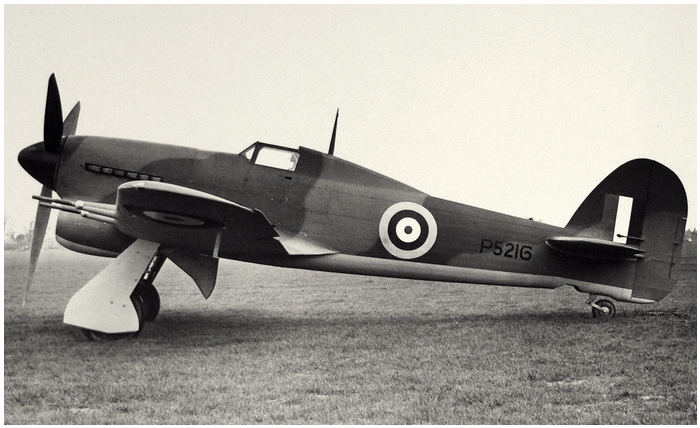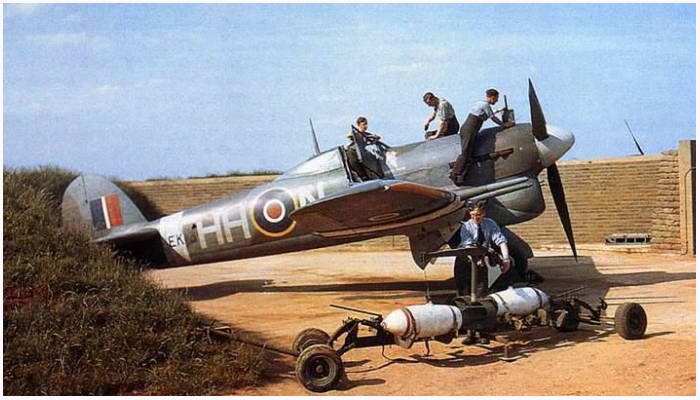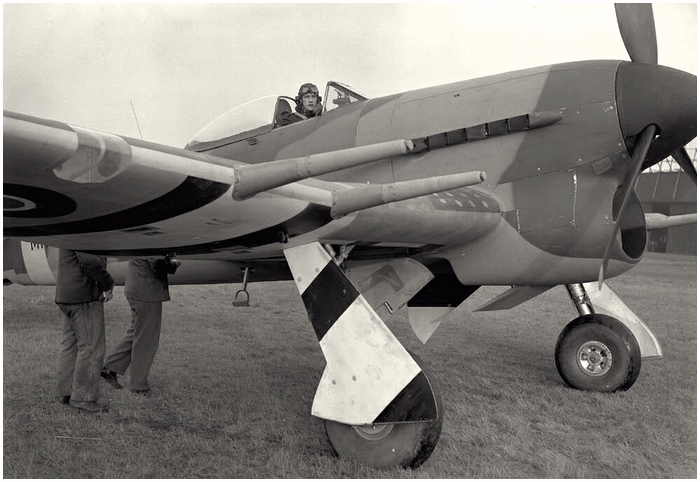
SPECIFICATION F.18/37
In 1938 the Air Ministry brings about Specification
F.18/37. It asked for a fighter with at least four 20mm
cannons. This type of heavy weapons asked for a powerful
engine, around 2000 hp. Hawker, in the middle of producing the
Hurricane, designs a type with twelve 7.7mm Browning
machineguns, but the Air Ministry stays with her
specification. In the United Kingdom there is a wide range of
engines to choose from. The choice goes to an inline engine
instead of the radial air-cooled Bristol Centaurus engine.
There were still designers who thought that only a liquid
cooled engine was capable of great performances. Designers
from Hawker, under leadership of Sidney Camm, produce two
fighters, one with the Napier Sabre (N) and one with the (R)
Rolls-Royce Vulture.
PROTOTYPE TORNADO AND TYPHOON

Prototype of the Hawker Tornado (P5219) with the
Rolls-Royce Vulture engine
(Notice the radiator under the fuselage)
Early 1938 the order came for four prototypes, two Type R
and two of Type N. The type with the Rolls-Royce Vulture was named
‘Tornado’ and the prototype with the Napier Sabre became the
‘Typhoon’. The Vulture from Rolls-Royce consisted of two
blocks, each with twelve cylinders in a X-configuration that
drove one shaft. The Napier Sabre was a double twelve-cylinder
boxer-type engine with two crankshafts that came together in a
reductionbox. Both engines were liquid cooled and the power
was in the same region, 2000 hp. The first Tornado was built
at Kingston and made on 6 October, 1939 here maiden flight.

The monster, the Napier Sabre engine
At first sight the prototype looked like a Hurricane,
because of the radiator under the fuselage and the wide base
of the landinggear that folded inwards. A novelty were the two
rows of exhausts on both sites, just as the cockpit-door that
looked as it came from a motorcar. Hawker got an order for
1000 planes, 500 Tornado’s and 250 Typhoons, the other 250
were to be built with the engine that was tested as the best.

A later prototype of the Hawker Tornado (P5224)
(With this prototype the radiator is mounted below the engine)
During testing at high speed, the airflow was disturbed around
the radiator, so this was brought to the chin, just as with
the prototype of the Typhoon. On 24 February 1940 the
prototype of the Typhoon was airborne for the first time.

The prototype of the Hawker Typhoon (P5212)
The high hopes for the design were a disappointment, the
747 km/hp they hoped for could not be reached and the engine
was unreliable. On 9 May 1940 during a testflight, testpilot
P.G. Lucas noticed that the fuselage was breaking apart. With
a brilliant emergency landing he brought the plane back. He
could have used his parachute, but then the data would be lost
in the crash of the fighter.

A pre-production model of the Hawker Typhoon (P5216)
IN PRODUCTION,
EXIT TORNADO, ENTER
TYPHOON
Because Hawker was producing the Hurricane, the Tornado was
to be built by AVRO and the Typhoon by Gloster, associated
company’s of the Hawker Siddley Group. In 1941 the companies
were ready to produce. The aircraft were more adjusted still,
such as the wheelwell doors, the four cannons were placed and
the tailplane with its rudder was enlarged. But the greatest
concern was the engine.

Close-up of the cockpit with the 'car-door'
and the extra glass in the back
Hawker got permission to install a
Centaurus. This Tornado made its first flight on 23 October,
1941. But it was to late, the Tornado-project was cancelled in
spite of that the plane performed better than the Typhoon,
less noise and much faster. Sidney Camm got in July, 1942
permission to install a Centaurus in a Typhoon II . Opposition
from Air Marshal Wilfrid Freeman, who was against the use of
radial engines, delayed the project once more and it went on
the shelf. Later it was brought back to life again and it
emerged as the Tempest (with later offspring’s the Fury and
Sea Fury. The Tempest would become the most successful fighter
of Hawker.

Typhoon IB (EK139), HH-N, 175 Sqn RAF, spring 1943
Gloster started production of her Typhoons on 27
May, 1941 at Hucclecote. The first badge of hundred had still
the twelve machinegun configuration, but the rest was built
with the four cannons. During production the testing continued
on the Typhoon, shorter wings, enlarged wings, single or
double charged or fit with camera’s. From the last, with the
camera’s, 60 were delivered to the RAF.

Production Typhoon EK286 in
April 1943 (still with the old cockpithood)
The first Typhoons were delivered to the RAF at the end of
September 1941, to No. 56 Squadron at Duxford. Here the
Typhoon became known as the ‘Tiffy’. It sounded rather
lovely but it was far from it. Often it was a nightmare. The
flying characteristics were okay and when the engine did run
it was a smooth as you could wish for. But the problems to
start the engine continued throughout it’s whole career, every
25 hours the Sabre needed a complete overhaul.

Under the wings of Typhoon EK183 the black/white striping is visible
(To counter the confusing for AA batteries that it were not Fw 190 fighters)
During air
battles with the FW 190, the Typhoon could not make a fist. If
the pilot made a violent manoeuvre, it could happen that the
tail snapped off. Many Typhoons were lost because of it’s weak
tail. To strengthen this point, engineers made a wreath of
small tags around the tail.
In January 1943 testing started on a better all clear ‘bubble’ canopy instead
of the heavy hood, with the ‘car-door’ entrance. The testing was very satisfactory
and the new canopy was introduced in the later models of the Typhoon, the Mk IB.

A nice close-up of a Typhoon
Mk IB (with 'bubble' canopy)
A NEW ASSIGNMENT
As a fighter the Typhoon was a failure and the Air Ministry
wanted to cancel the project. But the young pilot Rolant
Prosper Beamont from No. 609 Squadron convinces the Air Staff
of the enormous fighting potential the Typhoon has. Not as a
high flying fighter, but as ground-attack aircraft loaded with
bombs and later with rockets.
 
Roland Prosper Beamont and the insignia of 609 Squadron
When the trials proved very
successful, the complete inventory of Typhoons were placed in
the 2nd Tactical Air Force. The Typhoons had the shape similar
to the FW 190, and to anticipate any confusion the Typhoons
were in 1943 fitted out with broad black and white stripes.
Because of the landings in Normandy in 1944 every allied
aeroplane was later fitted with these stripes. Slowly the
heavy cockpit-hoods with the car-doors were replaced by a
bubble hood. Around D-Day, Gloster had delivered almost 2000
Typhoons and 26 squadrons of the 2nd TAF were equipped with
this fighter-bomber.

A Typhoon from 440 Squadron departs with bombs for a new mission
The Typhoon fitted perfect in her new role as a tactical
weapon. Ground forces were in radio contact with the pilots.
If there was an obstacle in their way, a German tank or
anti-tank weapon, they could call upon a group of Typhoons to
deal with those targets. The Typhoons would come in and use
all the weaponry it could carry, cannons, bombs and the 27 kg
rockets. In the third week of August the Typhoon brought havoc
on the retreating Germans in the ‘Falaise Pocket’. No vehicle
was safe if spotted by the Typhoon pilot or it’s directing
observer on the ground.

Typhoons in the 'Falaise Pocket',
a dramatic painting by Robert Taylor
After the introduction of the Hawker Tempest, the Typhoon
was, at the end of the war, swiftly pulled back from the front.
When the war was over,
there was hardly a Typhoon left. Today there is only one
complete airframe preserved, Typhoon Mk BI, MN235, in the RAF
Museum at Hendon.

This Typhoon has rockets under his wings
In Holland was a tailsection to be found at the museum of Twente airforce base. This Typhoon, Mk IB, RB396, XP-W of the no.174 Squadron made a crashlanding near Denekamp on 1 April 1945 after it was hit by anti-aircraft fire. The pilot, Flt Lt Chris House was not picked up by Germans looking for him, and House was back at his unit two days later. The wreck was stored at a chemical factory, but handed over to Twente and on a later date to Fort Veldhuis. One side was restored, the other side was left intact as it was.
Dave Robinson of the Hawker Typhoon Preservation Group lay his hands on the tailsection and it became the most important part to make a Typhoon airworthy again. The date to get it airborne again is set for 2024, eighty years after D-Day.

Typhoon Mk IB, RB396 under restoration tot fly again
(Foto: Airsoc)
There is another longtime restoration on Thyphoon, EJ922, QO-F, of No. 3 Squadron. It wil be
on display at Brooklands Museum at Weybridge. This specific Typhoon is of the ‘cardoor-type’,
of which the cockpit section was saved in the seventies of the last century. In the D-Day Museum,
at the airport of Shorham, UK, a Napier Sabre with a restored cockpit-section can be found. Of
its successor, the Tempest, are at least eleven preserved.

The Typhoon in the RAF Museum, at
Hendon
In the short period the Typhoon was operational, a lot of pilots lost their live in this aircraft.
During the missions over Normandy a 151 pilots were lost. At the end of its career the 666 pilots had
lost their live in the Typhoon.

A monument for the fallen Typhoon pilots over Normandy
can be found in Noyers-Bocage

Back to the top
RETURN
|